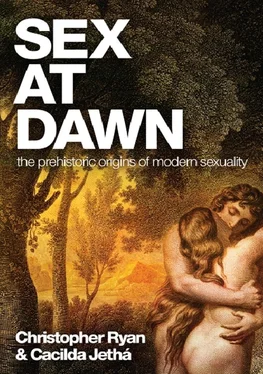Christopher Ryan - Sex at Dawn
Здесь есть возможность читать онлайн «Christopher Ryan - Sex at Dawn» весь текст электронной книги совершенно бесплатно (целиком полную версию без сокращений). В некоторых случаях можно слушать аудио, скачать через торрент в формате fb2 и присутствует краткое содержание. Жанр: Прочая научная литература, на английском языке. Описание произведения, (предисловие) а так же отзывы посетителей доступны на портале библиотеки ЛибКат.
- Название:Sex at Dawn
- Автор:
- Жанр:
- Год:неизвестен
- ISBN:нет данных
- Рейтинг книги:4 / 5. Голосов: 1
-
Избранное:Добавить в избранное
- Отзывы:
-
Ваша оценка:
- 80
- 1
- 2
- 3
- 4
- 5
Sex at Dawn: краткое содержание, описание и аннотация
Предлагаем к чтению аннотацию, описание, краткое содержание или предисловие (зависит от того, что написал сам автор книги «Sex at Dawn»). Если вы не нашли необходимую информацию о книге — напишите в комментариях, мы постараемся отыскать её.
Sex at Dawn — читать онлайн бесплатно полную книгу (весь текст) целиком
Ниже представлен текст книги, разбитый по страницам. Система сохранения места последней прочитанной страницы, позволяет с удобством читать онлайн бесплатно книгу «Sex at Dawn», без необходимости каждый раз заново искать на чём Вы остановились. Поставьте закладку, и сможете в любой момент перейти на страницу, на которой закончили чтение.
Интервал:
Закладка:
Nor does Pinker include Africa, with its never-ending conflicts, child soldiers, and casual genocides. No mention of Rwanda. Not a Tutsi or Hutu to be found. He leaves out every one of South America’s various twentieth-century wars and dictatorships infamous for torturing and disappearing tens of thousands of civilians. El Salvador? Nicaragua? More than
100,000 dead villagers in Guatemala? Nada. Absolutamente nada.
13. Why War? available online at http://realhumannature.com/?page_id=26. After we contacted him to ask how he could possibly justify the omission, Smith at first cited Wrangham and Peterson’s dismissal of bonobos as being less representative than chimps of our last common ancestor. When we pointed out that many primatologists argue that bonobos are probably more representative, that even Wrangham had revised his opinion on the point, and that in any case, it is factually wrong to say that chimps are our “closest non-human relative” without mentioning bonobos, he finally relented and added two brief references to bonobos to his lurid descriptions of chimps’ “bloody wars of attrition.” Since the online essay was an extract from his book, which was already in print, it seems unlikely these reluctant changes are reflected there.
14. Ghiglieri (1999), pp. 104-105.
15. For a review, see Sussman and Garber’s chapter in Chapman and Sussman (2004).
16. The quote is from de Waal (1998), p. 10.
17. Goodall (1971), cited in Power (1991), pp. 28-29.
18. Strangely, even though he agrees with this central point made by Power, de Waal barely mentions her work—and only to dismiss her, at that. In an endnote in his 1996 book, Good Natured: The Origins of Right and Wrong in Humans and Other Animals, he writes, “On the basis of her reading of the literature, Power (1991) has argued that provisioning at some field sites (such as Gombe’s banana camp) turned the chimpanzees more violent and less egalitarian, and thus changed the ‘tone’ of relationships both within and between communities. Power’s analysis—which blends a serious reexamination of available data with nostalgia for the 1960s image of apes as noble savages—raises questions that will no doubt be settled by ongoing research on unprovisioned wild chimpanzees.”
This dismissal of Power’s analysis strikes us as unjustified and uncharacteristically ungenerous. Regardless of whether or not she felt “nostalgia for the 1960s” (an emotion we didn’t detect in her book), de Waal admits her analysis “raises questions” that merit investigation. These questions threaten to recast a great deal of data concerning chimpanzee social interactions—of great interest to de Waal, one of the world’s leading authorities on chimpanzee behavior and a man whose scholarship demonstrates deep respect for critical analysis.
19. Ghiglieri (1999), p. 173.
20. For a review of these reports and a rebuttal to Power’s argument, see Wilson and Wrangham (2003). The paper is available online at http://anthro.annualreviews.org.
21. Nolan (2003).
22. Behar et al. (2008). Also, for an excellent review of this material, see Fagan (2004).
23. Turchin (2003 and 2006).
24. Readers with mental images of Sioux (Lakota) chiefs with eagle-feather war bonnets rippling in the wind should keep in mind that in the generations before first contact with whites, disease spread through many tribes and the arrival of horses brought severe cultural disruptions, leading to conflict between groups that had been at peace previously (see Brown, 1970/2001).
25. Edgerton (1992), pp. 90-104.
26. Ferguson (2003).
27. On Christmas Day, 1968, Apollo 8 astronaut Frank Borman read this prayer to a world audience: “Give us, O God, the vision which can see thy love in the world in spite of human failure. Give us the faith to trust the goodness in spite of our ignorance and weakness. Give us the knowledge that we may continue to pray with understanding hearts, and show us what each one of us can do to set forth the coming of the day of universal peace. Amen.”
28. Tierney (2000), p. 18. Tierney’s book sparked a conflagration that makes any chimpanzee community seem downright pacific in comparison. The bulk of the controversy concerns Tierney’s charges that Chagnon and his colleague, James Neel, may have caused a fatal epidemic among the Yanomami. Not having examined these charges in detail, we have nothing to add to that discussion, limiting our critique to Changnon’s methodology and scholarship as it applies to Yanomami warfare.
29. By comparison, Chagnon’s total time among the Yanomami adds up to about five years. Readers interested in knowing more about the Yanomani might start with Good (1991). This is a very personal and accessible account of his time living with them (and ultimately, taking a wife there).
Tierney (2000) outlines the case against Chagnon, though going far beyond the critiques we’ve outlined here. Ferguson
(1995) offers an in-depth analysis of Chagnon’s calculations and conclusions. For more of Ferguson’s views on the origins of war, the following two papers can be downloaded from his departmental web page ( http://andromeda.rutgers.edu/socant/brian.htm): Tribal, “Ethnic,” and Global Wars, and Ten Points on War, which includes a broad discussion of biology, archaeology, and the Yanomami controversy. Borofsky
(2005) offers a balanced account of the controversy and the context in which it occurred. Of course, Chagnon’s work is readily available as well.
30. Quoted in Tierney (2000), p. 32.
31. Washington Post review of Darkness in El Dorado: Jungle Fever, by Marshall Sahlins, Sunday, December 10, 2000, p. X01.
32. Chagnon (1968), p. 12.
33. Tierney (2000), p. 14.
34. Sponsel (1998), p. 104.
35. October 23, 2008.
1. Note that these numbers are for demonstration purposes only. To keep it simple (and since it’s meaningless anyway), we haven’t adjusted for male/female size differences, regional variations in average infant skeleton sizes, and so on.
2. October 6, 2008.
3. Adovasio et al. (2007), p. 129.
4. Gina Kolata, “Could We Live Forever?,” November 11, 2003.
5. Scientific American, March 6, p. 57.
6. Harris (1989), pp. 211-212.
7. http://www.gendercide.org/case_infanticide.html.
8. These numbers don’t include the selective abortion of female fetuses, which is widespread in these countries. For example, Agence-France Presse reports that selective abortions have left China with 32 million more men than women, and that in just one year (2005), more than 1.1 million more boys than girls were born in China.
9. Philosopher Peter Singer has written thought-provoking books and essays on the question of how to calculate the value of human versus nonhuman life. See, for example, Singer (1990).
10. Cited in Blurton Jones et al. (2002).
11. Blurton Jones et al. (2002).
12. See Blurton Jones et al. (2002).
13. An excellent paper highly recommended to readers interested in these matters is Kaplan et al. (2000). The paper can be downloaded at Kaplan’s faculty website: www.unm.edu/~hebs/pubs_kaplan.html.
14. From the paper by Kaplan et al. cited above, p. 171.
15. Readers interested in seeing how these same agricultural curses are playing out in the modern world might want to read Michael Pollan’s In Defense of Food: An Eater’s Manifesto
(2009).
16. Larrick et al. (1979).
17. Source: Diamond (1997).
18. Edgerton (1992), p. 111.
19. Cohen et al. (2009).
20. Horne et al. (2008).
21. While we’re on the subject of hammocks, we’d like to take this opportunity to formally propose that hammocks—not spear points or stone blades—were the first example of human technology. That no hard evidence for this proposal has been unearthed is due to hammocks being made of perishable fibers. (Who wants a stone hammock?) Even chimps and bonobos fashion primitive hammocks by weaving together tree branches for sleeping platforms.
Читать дальшеИнтервал:
Закладка:
Похожие книги на «Sex at Dawn»
Представляем Вашему вниманию похожие книги на «Sex at Dawn» списком для выбора. Мы отобрали схожую по названию и смыслу литературу в надежде предоставить читателям больше вариантов отыскать новые, интересные, ещё непрочитанные произведения.
Обсуждение, отзывы о книге «Sex at Dawn» и просто собственные мнения читателей. Оставьте ваши комментарии, напишите, что Вы думаете о произведении, его смысле или главных героях. Укажите что конкретно понравилось, а что нет, и почему Вы так считаете.












